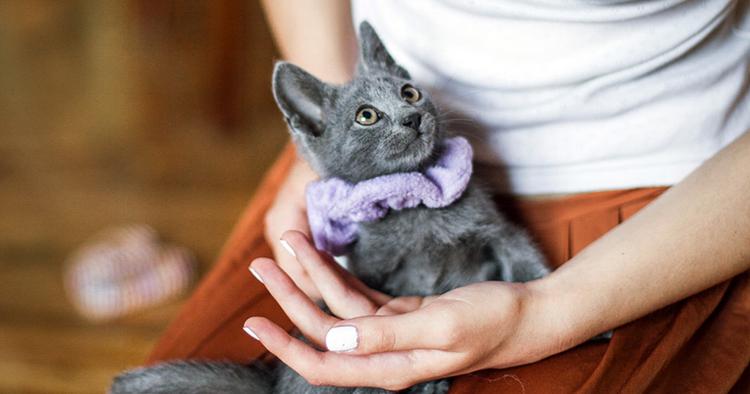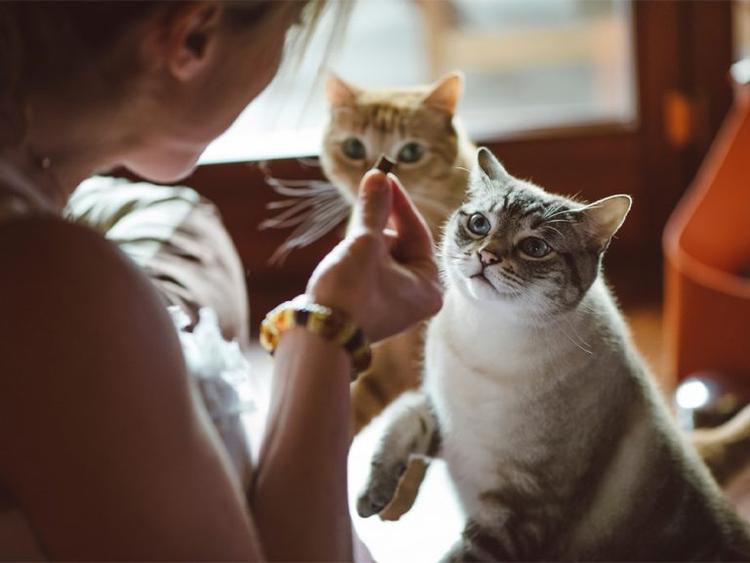How to Get a Cat to Like You (and Eventually Love You)
Is your new cat giving you the cold shoulder? Here’s how to get them to warm up.
Is your new cat giving you the cold shoulder? Here’s how to get them to warm up.
by Katie Koschalk, | March 28, 2024

Mikhail Nilov / Pexels
Unlike dogs, who tend to befriend almost any human, cats can be far more selective and guarded when meeting someone new. However, beneath their cool, cautious exterior lies a warm heart waiting to be won over.
So, how do you get your newly adopted cat or kitten to like you? It involves understanding your cat’s distinct communication cues, respecting their boundaries, using positive reinforcement, and being patiently persistent. In most cases, even the most aloof cat will eventually warm up to you. Read on to learn how to get that coveted purr of approval.
Cats have their own subtle yet unmistakable language, revealing their feelings through various behaviors. Look for these telltale signs that your cat likes you and is comfortable with you.
Purring
Head butting or rubbing against you
Cuddling with you
Communicating with you through meows or other pleasant vocalizations
Lying on you or near you
Kneading on you (aka making biscuits)
Relaxed body posture when near you
Sleeping close to you
Bringing you gifts (i.e., a toy or even some critter)
Licking (grooming) you
Showing you their belly
Greeting you when you come home
Enjoying playtime with you
To truly connect with your new feline companion, you need to become an expert at recognizing and deciphering your cat’s subtle cues. By understanding these signals, you can better respond to your cat’s needs and strengthen your bond. Let’s explore cats’ common body language cues in more detail.
A cat’s eyes are windows to their emotions. Wide-open eyes with dilated pupils indicate excitement or fear, so if you notice that, give your kitty some space.
On the other hand, eyes that appear half-closed and relaxed mean your kitty feels safe and comfortable. Also watch for slow blinks directed toward you, as they indicate contentment and security. And get this: one study found when humans engage in slow blinking with their cats, it can further strengthen the bond and build trust between them.
A cat’s tail can speak volumes about their mood. When a cat points their tail toward the ground, it’s usually a sign of fear, submission, or insecurity. Similarly, a twitching or thrashing tail signifies agitation or arousal.
What you want to see is a relaxed, upright tail, which suggests your cat feels content and safe.
Pay attention to the position of your cat’s ears. Upright ears that are facing forward are a sign of alertness and curiosity, while a slight tilt, either forward or to the side, can mean your cat is relaxed or interested in something.
If your cat’s ears are flattened against their head, give them space. This position, which is often accompanied by hissing or growling, indicates that your cat feels threatened or intimidated and may be preparing to defend themself.
A cat’s posture can reveal a lot about how they’re feeling. A relaxed, loose stance suggests comfort and confidence. And when a cat rolls over and exposes their belly to you, it’s a clear sign of trust, as this gesture reveals a vulnerable area of their body.
Conversely, a cat with a tense body and lowered head signals feelings of fear or submission. A fearful cat might also arch their back to appear larger and more intimidating to perceived dangers, or crouch low to the ground, signaling a readiness to react to potential threats.
A puffed-up coat, especially along the back and tail, indicates agitation or fear. Similarly, whiskers pulled back against the face can be a sign of unease or aggression.
In contrast, when your cat is relaxed, their fur will appear smooth and sleek, and their whiskers will extend outward from their face in a natural, unfurled position.
A cat’s vocalizations serve as a significant means of communicating with you. Content cats often express their happiness through purring, trilling, or high-pitched meows. If you have a particularly talkative cat, you might find that you can engage in a back-and-forth “conversation” with them.
On the flip side, cats may yowl or growl to express fear, frustration, or territorial aggression. Hissing is another surefire sign they want you to back out of their personal space.
Building a strong and meaningful bond with your new cat requires patience, understanding, and commitment. Here are some tips to get on their good side:
Spend quality time together: Dedicate regular, uninterrupted time to spend with your cat each day. Engage in activities they enjoy, such as interactive play sessions or simply lounging together.
Respect their space: Allow your cat to approach you on their terms, and respect their need for personal space. Never force an interaction, as this may cause your cat to fear you.
Practice positive reinforcement: Reward your cat with treats, praise, and affection whenever they exhibit desirable behaviors or show signs of affection toward you. Positive reinforcement helps cats connect a particular behavior with good things, which encourages them to do that behavior again.
Engage in interactive play: Stimulate your cat’s natural instincts by engaging in interactive play with toys such as feather wands, laser pointers, or puzzle feeders. This not only provides mental and physical stimulation, but also strengthens the bond between you through shared activities.
Handle your cat with care: Handle your cat gently, avoiding sudden movements or rough handling that may cause discomfort or anxiety. Approach them calmly and look for signs they want to be touched, such as leaning into you and purring.
Respect their preferences: Get to know your cat’s likes and dislikes (i.e., which kinds of toys, beds, or scratching posts they like). Provide a comfortable, enriching environment tailored to their preferences.
Learn their communication style: Pay attention to your cat’s body language, vocalizations, and facial expressions to better understand their moods and needs.
Establish a routine: Cats thrive on routine and predictability, so establish a consistent daily schedule for feeding and playtime to create a sense of security and stability.
Create safe spaces: Provide your cat with secluded areas or hiding spots where they can retreat when they need solitude or relaxation. This will help them feel safe and secure in their environment.
Be patient and persistent: Building a strong bond with your cat takes time and patience. Be consistent in your efforts to connect with them and remain patient, understanding that trust and affection develop gradually over time.
While all of the above tips for bonding with adult cats also apply to kittens, there are specific considerations to keep in mind when trying to build a connection with a new kitten.
Encourage early socialization: Kittens are particularly receptive to socialization during their early developmental stages. Introduce them to various people, noises, and sounds to help them develop confidence and adaptability.
Give them lots of playtime: Kittens have boundless energy and love to play. Engage your kitten in at least two to three 15-minute interactive play sessions throughout the day. They love feather wands, balls, or interactive puzzles that stimulate their natural instincts.
Create a safe environment: Cat-proof your house by removing or securing any potential hazards, such as toxic plants, household cleaners, medications, small objects that could be swallowed, electrical cords, and sharp objects. Install window screens and secure balconies to prevent escapes.
New cats often hide when they’re in a new environment because they feel stressed or overwhelmed. It’s a natural response to unfamiliar surroundings. To help your cat feel more comfortable, provide hiding spots and give them time and space to adjust at their own pace.
Your new cat might be scared of you because they’re feeling overwhelmed in their new home or due to past negative experiences with humans. Give them space and time to decompress. As they become more comfortable and trusting, they will likely warm up to you.
You can encourage your cat to come to you by sitting or kneeling calmly a few feet away from them. Say their name in a calm voice and extend your hand for them to sniff. Allow them to approach at their own pace. Once they allow you to pet them, reward them with a treat to reinforce the behavior.
To introduce a new cat to resident cats, start by separating the new cat in a room with all the essentials. Feed the cats on either side of the door, gradually moving their dishes closer to the barrier day by day. Next, initiate a scent exchange (i.e., swapping bedding), then supervise visual introductions, and finally initiate short supervised interactions.
8 Tips for a Successful Meet and Greet with a Cat

Katie Koschalk is a freelance writer based in Northern California. Fusing her love and knowledge of animals with her journalism degree and years of professional writing, Katie is dedicated to improving the lives of pets and their caretakers by sharing helpful and accurate information. When she’s not at her desk, you can find her exploring trails with her Aussie, Hunter, cooking plant-based meals, and talking to her two cats, Jax and Sadie, in really ridiculous voices.

Adoption Advice

Adoption Advice

Adoption Advice

Shelters & Rescue

Behavior & Training

Behavior & Training

Adoption Advice
Biases and preferences can get in the way of adopting a perfectly adorable cat. Here’s a look at the least adopted cats, and why they tend to languish in shelters.

Behavior & Training
From play bites to I’m-in-pain bites, we break down the many reasons felines may sink their teeth into you — to help you fix the issue.
